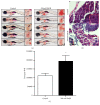Hesperidin Protects against Acute Alcoholic Injury through Improving Lipid Metabolism and Cell Damage in Zebrafish Larvae
- PMID: 28596796
- PMCID: PMC5449749
- DOI: 10.1155/2017/7282653
Hesperidin Protects against Acute Alcoholic Injury through Improving Lipid Metabolism and Cell Damage in Zebrafish Larvae
Abstract
Alcoholic liver disease (ALD) is a series of abnormalities of liver function, including alcoholic steatosis, steatohepatitis, and cirrhosis. Hesperidin, the major constituent of flavanone in grapefruit, is proved to play a role in antioxidation, anti-inflammation, and reducing multiple organs damage in various animal experiments. However, the underlying mechanism of resistance to alcoholic liver injury is still unclear. Thus, we aimed to investigate the protective effects of hesperidin against ALD and its molecular mechanism in this study. We established an ALD zebrafish larvae model induced by 350 mM ethanol for 32 hours, using wild-type and transgenic line with liver-specific eGFP expression Tg (lfabp10α:eGFP) zebrafish larvae (4 dpf). The results revealed that hesperidin dramatically reduced the hepatic morphological damage and the expressions of alcohol and lipid metabolism related genes, including cyp2y3, cyp3a65, hmgcra, hmgcrb, fasn, and fads2 compared with ALD model. Moreover, the findings demonstrated that hesperidin alleviated hepatic damage as well, which is reflected by the expressions of endoplasmic reticulum stress and DNA damage related genes (chop, gadd45αa, and edem1). In conclusion, this study revealed that hesperidin can inhibit alcoholic damage to liver of zebrafish larvae by reducing endoplasmic reticulum stress and DNA damage, regulating alcohol and lipid metabolism.
Figures




References
-
- Bok S. H., Lee S. H., Park Y. B., et al. Plasma and hepatic cholesterol and hepatic activities of 3-hydroxy-3-methyl-glutaryl-CoA reductase and acyl CoA: cholesterol transferase are lower in rats fed citrus peel extract or a mixture of citrus bioflavonoids. The Journal of Nutrition. 1999;129(6):1182–1185. - PubMed
-
- Park Y. B., Do K. M., Bok S. H ., Lee M. K., Jeong T. S., Choi M. S. Interactive effect of hesperidin and vitamin E supplements on cholesterol metabolism in High cholesterol-fed rats. International Journal for Vitamin and Nutrition Research. 2001;71(1):36–44. - PubMed
LinkOut - more resources
Full Text Sources
Other Literature Sources
Molecular Biology Databases
Research Materials
Miscellaneous

